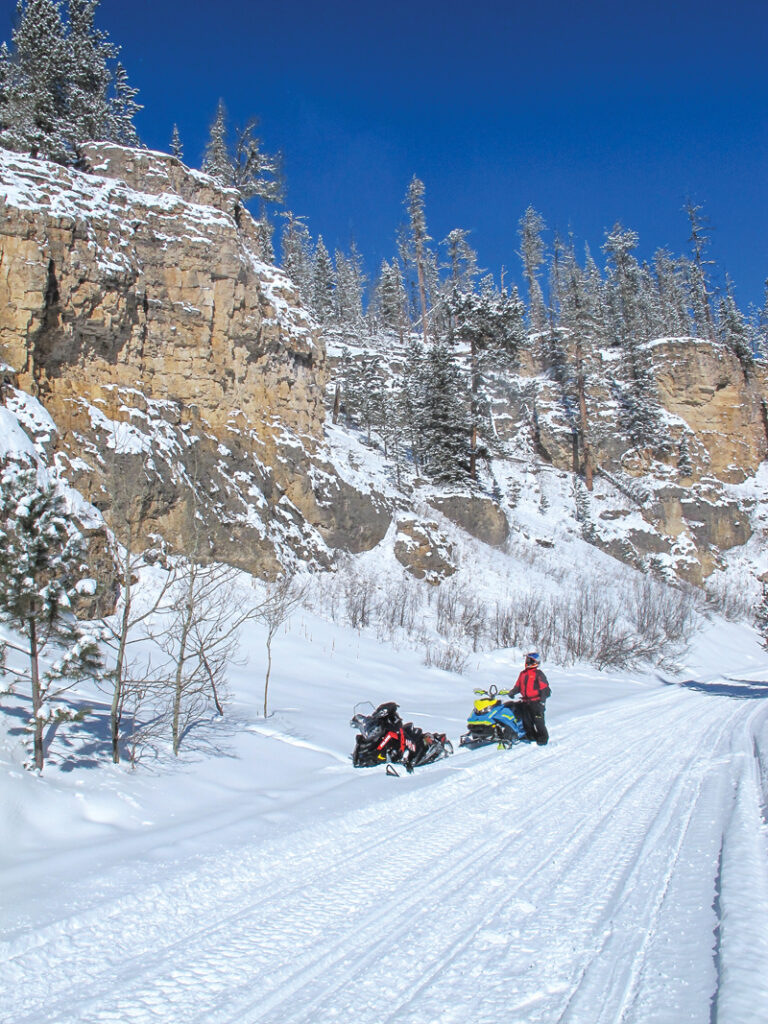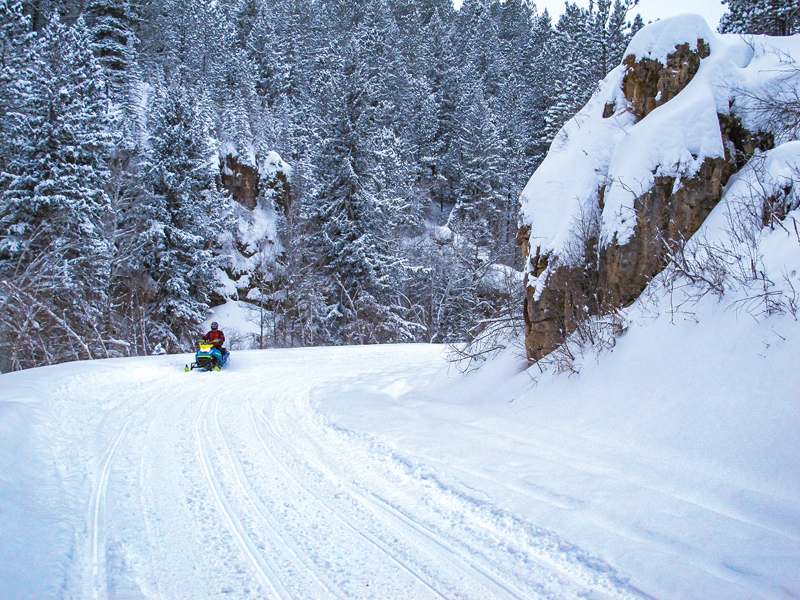Editor’s Note: The Black Hills of South Dakota offer some of the best snowmobiling in North America. It was captured in this Snow Goer article, which first appeared in the January 2019 issue of the magazine. It was then used again in Snow Goer’s Great Escapes. Click through to read the full article and more images, here we offer this shortened version.
Making Our Own History: Fresh Snow, Great Scenery & Good Times In The Black Hills

On August 2, 1874, an expedition led by George Armstrong Custer discovered gold in the southern Black Hills of the Dakota Territory, touching off one of the greatest gold rushes in the history of the United States…
On February 17, 2018, a Snow Goer magazine editor discovered online that there was fresh snow in the Black Hills, and more in the immediate forecast, touching off a rush to find a riding partner…
Upon hearing reports of the riches in the Black Hills, brothers “Colorado” Charlie and Steve Utter organized a wagon train to Deadwood, stopping along the way to pick up more than 100 passengers, including now-infamous characters like Martha Jane “Calamity Jane” Canary and James “Wild Bill” Hickok in Wyoming. They arrived in Deadwood on July 12, 1876.
Upon hearing the reports of deep snow in the Black Hills, we added brother-in-law Steve to our wagon train (a Tahoe and four-place trailer) the next morning and began our should-have-been nine-hour drive to Deadwood. We arrived after midnight.
Hickok’s time in Deadwood wouldn’t last long, though it was rowdy and entertaining. His last night was August 2, 1876, when he was shot dead in the No. 10 Saloon on Main Street during a poker game, holding the “dead-man’s hand” of aces and eights. You can still visit his gravesite outside of Deadwood to this day.
Our time in the Black Hills wouldn’t last long, though it was some of the best snowmobiling ever, with awesome trails, stunning scenery, endless off-trail possibilities and wonderful, fresh snow. Our last night was the opposite of Wild Bill’s in Deadwood’s Saloon No. 10: We had decent luck at the No. 10 Saloon’s blackjack table. However, you can you still visit the site outside of Deadwood where Steve buried a Ski-Doo in deep powder.
Snowmobiling At Its Best

You may think you’ve seen the greatest that snowmobiling has to offer, but we would dare say that South Dakota’s Black Hills truly rivals the best of the best. It has fascinating, exposed-granite topography and wide, expertly maintained trails that weave in and out of pine forests, across meadows, along rivers and in the shadows of towering rock faces.
Mix in the awesome adult playground that is the historic, raucous town of Deadwood and you’ve got a snowmobiler’s nirvana.
Those looking for extremes may note the area’s limitations. There are 350 miles of trails in the Black Hills system, which may sound small to some high-mile cruisers. The region’s highest peak sits at 7,250 feet, which may sound shallow to mountain riders. But for a trail rider looking to experience a high-altitude feel without high-altitude downfalls plus the thrills of off-trail exploration, this is a great place to be.
All totaled, the Black Hills National Forest is 1.2 million acres large, with seven peaks above 7,000 feet. Most snowmobiling is done between 4,000 and 6,500 feet.
Getting Started

After confirming snow, we pointed our truck west out of Minneapolis. Though windy, the first 7 hours went by quickly. When we reached the western third of South Dakota, however, things got dicey. First we experienced icy roads caused by wind-blown snow. Later heavy-falling snow made visibility next to nothing and flashing roadside signs suggest no travel. We soldiered on.
After cruising Deadwood’s historic Main Street, we found the Deadwood Gulch Resort on the southwest edge of town. It was mostly dark, except for the flashing casino lights on the far end of the building. Pulling back the shades in our motel-style room the next morning, we saw fresh snow everywhere. It was go time.
Trail 7 (which bisects the resort’s parking lot) weaves through the remainder of Deadwood, over fancy bridges and behind a few businesses, then crosses highway 85 and 385 before the first decision needs to be made. A right at the “Y” take riders into the neighboring mining town of Lead while staying left on Trail 7 gets you into prime riding country more quickly. With full fuel tanks and no need for food, we went left.
The snowmobile trail soon followed the edge of a steep cliff off to the left. Unlike many other local geographic features, this one wasn’t created by volcanic eruptions or other upheavals. Instead, we were riding along the upper edge of the Wasp Mine, and thus next to the massive hole that was dug, blasted and otherwise unearthed between 1893 and 1920. According to an informative trailside sign, more than 100,819 ounces of gold and 158,780 ounces of silver were pulled from the earth at this site by 1920.
The history was interesting, but we were there to ride, so we moved on. We motored south and west on a combination of trails that let us get reacquainted with the Black Hills National Forest.
Great Riding

The Black Hills were named from a translation of a Lakota Indian phrase “paha sapa,” which means “hills that are black.” It was called that because the towering hills look dark from a distance due to their dense forests.
Pretty much every trail has broad sections that are lined with trees. They are predominantly evergreen like ponderosa pine and Black Hills spruce, but you’ll also come upon sections of white-trunked quaking aspen and paper birch plus occasional oak and ash hardwood trees that decorate the landscape.
The trees, though, are generously spaced in most areas, allowing sunlight to pour through. Plus, there are many broad clearings with open meadows that serve as food lots for wildlife, and playgrounds for us.
We explored most of the trail network in the northeast portion of the national forest the first day. The trails were wide and groomed flat, and signage at intersections left no doubt where we were headed.
When empty stomachs started to growl by mid-afternoon, we followed the signs toward one of the most renowned snowmobiling destinations in the Snowbelt – the Trailshead Lodge. Since its founding in the 1980s, Trailshead Lodge has been dedicated to snowmobiling and other trail-based activities. In fact, the trails in the immediate area were designed around its location. With gas, food, sled rentals, service and other amenities on-site, a handful of modern cabins out back and a huge parking lot across the street, it truly is a hub.
There are two locations to the north that first-time Black Hills visitors simply must visit. Our favorite is the weaving trail up to Spearfish Canyon past Roughlock Falls. It follows a river bed that carves through towering walls of exposed granite. Seeming to defy logic, trees with exposed roots grow out of the rock-hard surface. In other places water seeps through the walls, making frozen creations that melt on warm days.
The other side-venture is a trip across the Wyoming border to the Cement Ridge Lookout. At 6,647 feet, it’s one of the highest points in the northern Black Hills. That allows a panoramic view in all directions. We were quickly running out of daylight, though, so we hightailed it back toward Deadwood.
We were tired, but re-energized ourselves with caffeine so we could go explore downtown Deadwood. The blizzard-like conditions that had socked in the area made Deadwood less festive than we’d experienced on previous visits. But it was still fun popping in and out of casinos and bars, seeing some live entertainment and catching a great meal.

The Sun Arrives
The two-day winter storm that made our in-coming drive sketchy broke overnight. We were greeted to picture-perfect conditions on our second day of riding. The snow glistened under some of the deepest blue skies imaginable. The disappearing cloud blanket, though, let in some bitterly cold air.
The northern half of the Black Hills trail network has the most dependable snow so we’d explored all of it on previous visits. This fresh snow, however, meant the groomers were able to work the system all the way to its southern tip. So we went exploring.
The morning involved riding the mishmash of wonderful trails out of Deadwood and Lead again. We found more towering granite walls and a more open feel to the trails as we worked our way south, passing creeks and meadows and weaving past summer campgrounds.
Eventually we made it to a spur trail, with signage that promised that Flag Mountain Lookout would be found at the top. That short trail itself was spectacular – lined with pine trees with boughs laden with the two previous-days’ snow intermixed with huge, exposed boulders as we gained altitude.

The real payoff, though, was at the top. We parked our sleds, followed a very short walking path and found ourselves suddenly at the edge of a cliff! Flag Mountain sits at 6,937 feet. Equally notable, it sits very high above the lower Reynolds Prairie immediately to its east. That made it seem even more startling high than Cement Ridge.
We climbed around on the rocks at this high point to get different perspectives on the surrounding scenes. We also gazed at a dilapidated mine shaft building at the top. Remounting our sleds, we zoomed back down the spur trail, hung a left on the main trail and twisted our way through a large rolling meadow until we came to the charming Mt. Meadow Resort. We lunched inside the drafty building while the wind whistled outside. We then fired the sleds again for the scenic on- and off-trail ride back to Deadwood.
White Gold, Indeed
Cliché’s about “white gold” aside, we definitely found our treasure snowmobiling in the Black Hills.
Weather patterns here tend to the extremes. Big snows are often followed by big warm-ups, so conditions can be excellent one week and marginal the following week. Being adaptable in your timetable is key. But when conditions are good in the Black Hills, the area offers world-class snowmobiling, affordable lodging and endearing entertainment.
Editor’s Note: Every Snow Goer issue includes in-depth sled reports and comparisons, aftermarket gear and accessories reviews, riding destination articles, do-it-yourself repair information, snowmobile technology and more. Subscribe to Snow Goer now to receive print and/or digital issues.


